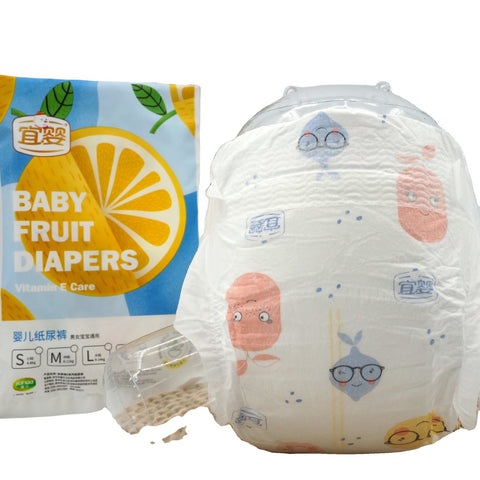From our lenses, diapers are essentially wearable bags of fabric-like material. While this motherhood staple appears to be simply made, there are more hidden parts to diapers than one might expect.
According to the French Agency for Food, Environmental, and Occupational Health and Safety (ANSES) in 2019, 38 chemicals of acute severity were discovered in several best-selling diapers.
Besides the outer waterproof plastic films and wood pulp fluff, the materials making up a diaper may include chemicals like dioxins (from chlorine used in bleaching), VOC (byproducts from absorbent material), or sodium polyacrylate that allow them to function well.

Credit: BabyGearLab
The chemicals have also set alarm bells ringing due to the health risks that they could cause for newborns and developing infants. Furthermore, due to the 'trade secret' status of fragrances, manufacturers are still not required by the FDA to disclose their ingredients on the label or in any other way and can bury potentially toxic chemicals under the "Fragrance" ingredient item.
Indeed, some of the chemicals in diapers are known to be toxic to human health.
What’s worrying is that these nappies have been sold throughout the time, and continue to permeate the baby products market worldwide. This is despite the dangers of such chemicals, from disrupting hormones to precipitating latent diseases in the long run.
Dioxins

Credits: USGS
One major group of chemicals found in the wood pulp of diapers are dioxins, which do not pass on any desirable trait to diapers. But why are they then so commonly found in diapers? These chemicals are formed as unwanted by-products from the bleaching of diapers to white and are incredibly difficult to remove.
Based on findings from the World Health Organisation (WHO), dioxins are one of the most toxic chemicals to ever exist and have been marked as highly carcinogenic by the U.S. Environmental Protection Agency (EPA).
Exposure to dioxins might leave you with nasty skin reactions or an organ system that goes out of kilter, be it your immune system, nervous system, or reproductive system.
Volatile organic compounds (VOCs)

Credits: AZoM
Another typical group of chemicals in diapers are VOCs, some of which have rather cool-sounding but lengthy names such as 1,3-butadiene and tetrachloroethylene. Similar to dioxins, VOCs are also formed as side products that are emitted as gases during the manufacture of diapers.
Based on EPA reports, children are at risk of developing various health conditions from exposure to VOCs ranging from mild symptoms, such as eye or nasal irritation, to severe symptoms, such as kidney or liver damage.
Fragrances
Aromatic compounds such as esters are used in scented diapers. In between the adsorbent core and the external layers of a diaper lies a tiny bit of the “perfume”, which usually has a compound found in citrus oils called citral.
Not only do they beautify the scent of diapers, but aromatic chemicals also help to mask unpleasant odors that might have arisen during the manufacturing process, or whenever the baby does its business. Furthermore, it has been a marketing tactic to evoke maternal emotions as mothers tend to enjoy the all-to-familiar whiff of fresh diaper fragrance.

Credits: Alibaba
Alas, mothers are discouraged from buying scented diapers due to how the fragrant chemicals could irritate their child’s skin with allergies and painful rashes. This is especially so for children who have naturally sensitive skin.
Sodium polyacrylate
As a super absorbent polymer (SAP) that lines the insides of disposable diapers, SAP allows diapers to absorb large volumes of fluid without any leakage. The quantity of water absorbed by SAP is around 500 to 1000 times its weight!
If you are still not convinced, you can perform a "disappearing water" magic trick on a diaper, which you first lay on a table. Pull out some of the diaper fibers before piling them together. Then, remove the top fibers to reveal white SAP granules. Gradually, pour water into the granules and you would see a gel instantly form. Such a gel prevents the water from leaking out of the diapers!

SAP gel on top; SAP granules below (Credits: Alibaba)
However, this chemical has its fair share of harm such as potential skin irritations. In the 1980s, the SAP in tampons allegedly contributed to toxic shock syndrome (TSS) in female users.
However, it has been acknowledged that the women could have used the same tampons for too long, forming a breeding ground for bacteria which could have been the actual cause of the TSS outbreak. Other safety issues have been raised regarding the use of SAP, such as being a possible carcinogen, as claimed by the Occupational Safety and Health Administration (OSHA).
Nonetheless, nearly all diapers have SAP in some form or another for their highly desirable absorbent properties. Thus, the best solution for babies who are sensitive or allergic to this chemical would be to invest in cloth diapers which typically lack SAP.
Thankfully, most diaper companies have a catalog of safety protocols in place to control and regulate the levels of harmful or potentially harmful chemicals in their products. You have a post sharing the dangerous chemicals in a disposable diaper.
Still, whether the constant or prolonged use of such chemicals jeopardizes babies’ immediate or future lives remains a hot potato today. You can read about how long it takes for a diaper to decompose.
As such, diaper consumers, especially parents, ought to be aware of the risks of commonly used chemicals. This would help them make more informed purchasing decisions, such as buying unscented or dioxin-reduced diapers. You can also read more about the types of cloth diapers.
